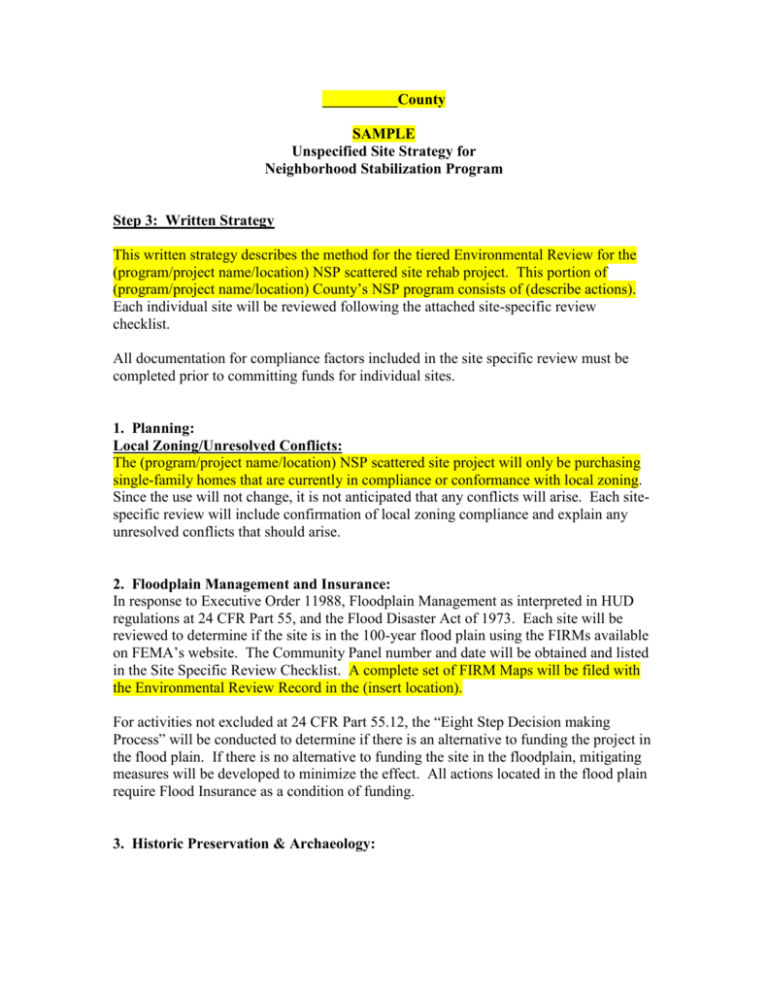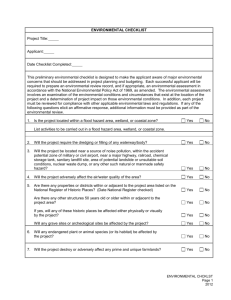Habitat for Humanity of Forsyth County
advertisement

__________County SAMPLE Unspecified Site Strategy for Neighborhood Stabilization Program Step 3: Written Strategy This written strategy describes the method for the tiered Environmental Review for the (program/project name/location) NSP scattered site rehab project. This portion of (program/project name/location) County’s NSP program consists of (describe actions). Each individual site will be reviewed following the attached site-specific review checklist. All documentation for compliance factors included in the site specific review must be completed prior to committing funds for individual sites. 1. Planning: Local Zoning/Unresolved Conflicts: The (program/project name/location) NSP scattered site project will only be purchasing single-family homes that are currently in compliance or conformance with local zoning. Since the use will not change, it is not anticipated that any conflicts will arise. Each sitespecific review will include confirmation of local zoning compliance and explain any unresolved conflicts that should arise. 2. Floodplain Management and Insurance: In response to Executive Order 11988, Floodplain Management as interpreted in HUD regulations at 24 CFR Part 55, and the Flood Disaster Act of 1973. Each site will be reviewed to determine if the site is in the 100-year flood plain using the FIRMs available on FEMA’s website. The Community Panel number and date will be obtained and listed in the Site Specific Review Checklist. A complete set of FIRM Maps will be filed with the Environmental Review Record in the (insert location). For activities not excluded at 24 CFR Part 55.12, the “Eight Step Decision making Process” will be conducted to determine if there is an alternative to funding the project in the flood plain. If there is no alternative to funding the site in the floodplain, mitigating measures will be developed to minimize the effect. All actions located in the flood plain require Flood Insurance as a condition of funding. 3. Historic Preservation & Archaeology: The project will/will not involve any houses more than 50 years old. We do not anticipate building in or adjacent to a historic district nor do we anticipate that the property’s area of potential effects will include a historic district or property. Should that occur, however, a State Historic Evaluation Form will be submitted directly to the State Historic Preservation Office. The appropriate tribes will be contacted for any project involving land disturbance. 4. Noise Abatement: Noise levels will be estimated using the HUD Day Night Average Noise (DNL) calculator if the project is within 5 miles of a civil airport, 1,000 feet of a major highway or busy road, or 3,000 feet of a railroad. 5. Hazardous Industrial Operations: Project involves existing single-family homes with no potential increase in level of occupancy. Therefore, compliance is not required. 6. Airport Hazards: The target area is not within the existing Runway Protection Zone, proposed future Runway Protection Zone or the proposed area for expansion of Gastonia Municipal Airport. Once individual sites are identified, compliance and certification will be noted on the individual site-specific checklist. 7. Protection of Wetlands: FEMA maps, Department of Interior Wetland Maps, and dated site visits will be reviewed to determine presence/absence of wetlands. 8. Toxic Chemicals and Radioactive Materials: Each project site will be evaluated to assure it is not listed on an EPA Superfund National Priorities or CERCLA List, or equivalent State list; located within 3,000 feet of a toxic or solid waste landfill site; does not have an underground storage tank (which is not a residential fuel tank); or suspected of contamination by toxic chemicals or radioactive materials. 9. Endangered Species: Where ground disturbance will occur, the list of endangered species will be reviewed and USF&W contacted where necessary. 10. Farmlands Protection: Project does not involve conversion of land use. 11. Flood Insurance: Each site will be reviewed to determine if the site is in the 100-year flood plain using the FIRMs available on FEMA’s website. The Community Panel number and date will be obtained and listed in the Site Specific Review Checklist. 12. Environmental Justice: Individual sites will be evaluated to determine if they are located in a predominantly minority and low-income neighborhood, and if so, whether there will be disproportionately adverse environmental effects on minority and low-income populations relative to the community-at-large.







